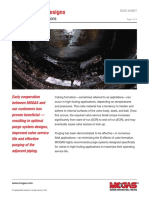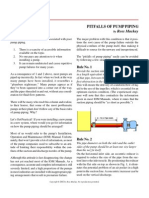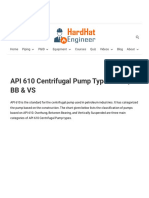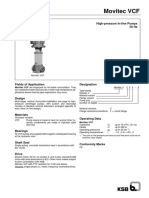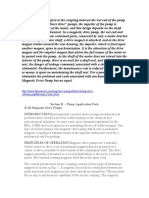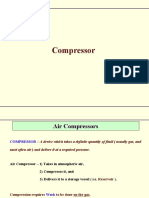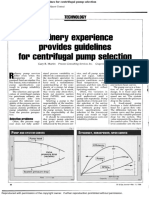0 ratings0% found this document useful (0 votes)
65 viewsPump Sizing - Adding Minimum Flow To Pump Rated Flow
When adding minimum flow to pump rated flow ?
Uploaded by
Ahmed SeliemCopyright
© © All Rights Reserved
Available Formats
Download as PDF or read online on Scribd
0 ratings0% found this document useful (0 votes)
65 viewsPump Sizing - Adding Minimum Flow To Pump Rated Flow
When adding minimum flow to pump rated flow ?
Uploaded by
Ahmed SeliemCopyright
© © All Rights Reserved
Available Formats
Download as PDF or read online on Scribd
You are on page 1/ 7
IFLOW - “WHEN” AND “WHY”
By: Muhammad Imaran- Mechanical Rotating Engineer ~ LUKOIL Overseas Services 8.V Dubai
ultimate goal of using a Centrifugal Pumps is to maintain a certain flow rate (in3/h) in the syste
‘ata certain time. Flow rate demands can be intermittent or continuous, fixed or variable within a
range from zero {no flow) to a certain maximum. Centrifugal pumps are flexible to meet the process
demand variations; however itis inherent design feature of the centrifugal pumps that they are limited
for a certain minimum flow rate called “minimum continuous flow = MCF” below which it is not
recommended to operate the pump in a-continuous manner.
C= Pumps are the most widely used Rotating Equipment In the process plants. The
Unlike positive displacement pumps, centrifugal pumps behave differently when the system resistance
(line backpressure) changes. An increase in the system resistance kills the pump differential head and
the pump is able to maintain a lower flow rate in the system. Similarly, a decrease in the system
resistance enables the pump to maintain a higher flaw rate, This characteristic of centrifugal pumps is
widaly used in a controlled manner to achieve flew regulation in order te meot the process demand
variations
‘There are possibilities when the system resistance may change in an uncontrolled fashion, for example,
cchocking of heat exchanger tubes in the downstream or a sudden closure of the discharge valve etc. This
may cause that pump operating point to move further left beyond the MCF point and may even push
the pump into shut-off condition resulting in a catastrophic pump failure:
Pump selection becomes challenging when the process flow demand falls below the MCF capability of
the available centrifugal pumps. In such cases, a larger centrifugal pump is selected with a particular
system design such that the process demand is fulfilled without having to operate the pump below the
MCF point.
Various methods are used to prevent the pump operation below the MCF point and to avoid the
‘operation at shut-off condition. Commonly used methods include "Minimurn continuous flow control
valve", “Automatic reciraulation valve" or using a “Minimum continuous flow by-pass line’, the last one
being the simplest method used for the smaller size pumps.
This paper deseribes how centrifugal pump protection is achieved by using MCF by-pass line and how
‘the pump sizing is done for this particular case.
MCF BY-PASS LINE - HOW IT WORKS:
Figure ‘.a shows schematic for a simple pumping system. In case of any increase in the systern
resistance, the pump operating point (red dot) moves upwards along the Q-H curve. If the system
resistance keeps on increasing, the pump operating point keeps riding up the curve until it reaches the
MCF point (black dot). If the system resistance keeps on increasing further, the operating point moves
beyond the MCF point and may finaly reach the shut off point if the pump discharge is fully blocked.
11Pa
nun Game caiman)
Operating region below
minimum continuous flow
Figure 1-2: Typical Pumping System without MCF Protection
Figure L-b shows a typical pumping system with KICF by-pass line, The by-pass line consists of a suitably
sized orifice plate with an appropriate line size leading back to the suction system. The MCF by-pas line
provides an additional flow path in the pump discharge system which remains continuously open thus
‘ensures that certain minimum flow is always passed through the pump. Im this case, even if the pump
discharge is fully blocked, the system resistance does not increase beyond the MCF point of the purnp
and hence the operating point dees not fall below the MCF region.
2IPage
Figure 1-a: Typical Pumping system with MCF By-Pass Line
PUMP SIZING FOR MCF BY-PASS SYSTEM:
‘There are various applications where MCF by-pass line is the most suitable method for the centrifugal
pump protection. There are cases when the rated flaw rate is too small to be covered by the available
centrifugal pumps, so a bigger capacity pump is selected and operated at a larger flow with continuous
spill back for the exeoss flow. In another case, the pump contrals are simplified by adopting the
minimum continuous flow line. A good example is application of Jockey Pumps in the Fire Water Pump
‘system when pump is continuously operated without using a pressure sensing line. In all these cases,
alPage
the pump sizing is done based on “Rated Flow + Minimum Continuous Flow” rather than the "Rated
Flow’. Following details are provided to explain how and why this pump sizing practice works to achieve
the desired p ump performance.
Example: Cold Condensate Pumps - Steam Generation and Distribution System
Following figure shows section of data sheet with operating conditions for a centrifugal pump in the
steam generation and distribution system of a Gas Treatment Plant,
CAPACITY, NORMAL _{0.70MF mits RATED 1150ME mn
omer Minimum flow (MF) _1.7m3/m
108
DIFFERENTIAL HEAD 113m NPGHA 7.8/5.7 (19)
HrDRALLIC POWER CI
Fig.2: Section of Pump Data Sheet — Cold Condensate Pumps
‘The pumps in the above example were part of the system where the system resistance was variable.
‘There was an all-time possibility of increase in the system resistance leading the pump operation below
the MCF point or even pushing the pump into dead head (shut-off} condition when occasionally the
system demand was zero. Therefore, pump MCF protection was required. However, considering that the
pump was very small (flow / head: 11.8m3/h / 1113m) and a too small quantity of MCF (1.7m3/h), a
minimum continuous flow by-pass line was selected as the best eption for pump MCF protection,
‘The pump selection was done based on flow rate “rated flow + minimum flow” instead of just “rated
flow”. The following description explains why and how this pum pselection basis werk.
Let us assume we select the pump based on “Rated flow’ instead of “Rated flow + minimum flow”.
When the minimum continuous flow by-pas line is added to this pump, the system behaves as if the
discharge line size has increased. In other words, the system has an additional flow path which causes a
Gecrease in the system resistance. In this case, the pump is able to maintain an overall higher flow rate
in the system consuming additional chunk of the differential head produced by the pump causing the
pump operating point to move down the curve. This causes loss of flow/head to the main process as
shown Figure 2
4iPa
Fig-2: Pump Selected for RF without Considering MCF & Operated with MCF By-pass
SlPage
‘The illustration in Figure 2 shows how the overall flow maintained by the pump is increased but the
head/flow to the main process is decreased. Therefore, the pump behaves as an undersized pump for
the required process demand.
‘The correct way of sizing the pump in the above examples to add MCF to the RF, thus the pump should
be sized for (11.8 + 17 = 13.5 m3/h). A pump sizing based on this approach would not cause any
head/flow loss to the main process as illustrated in Figure 3 below.
4m
” Friction Head
(rm HEHE secon and
StaticHead
ain Process flow: QfmaMny
Totalflow through pump 11.8 + 17
Gaya (21.8 41.7) a/b
Qiag = 7 mh
Fig-3: Pump Selected for (RF + MCF) & Operated with MCF By-pass
6lPace
CONCLUDING REMARKS:
Pump MCF protection is a critical requirement for the centrifugal pumps and must be carefully
addressed during the FEED and EPC detail engineering stage. Falling to provide MCF protection may
result into catastrophie failure of the pump during operation. The process engineer must assess the
pumping system and define the MCF protection requirement in the process data sheet for the pump and
the same should be indicated in the P&ID's. When a MCF by-pass line is required, the process and
mechanical data sheet must say "Rated flow: X + MCF” where X = Rated Flow & MCF = Minimurn
Continuous Flow. Alternatively, a nots may be added in the “Rated Flow" celumn to say “Pump is
provided with MCF by-pass line, the pump MCF shall be added to the Rated Flow". The Rotating
Equipment Engineer must be qualified enough to interpret this requirement in the process data sheet
and P&ID’s and must ensure this requirement Is Incorporated in the pump sizing during the TBE
(technical bid evaluation) stage. The orifice plate: required for the by-pass line must be induded in the
pump vendor scope. The pump vendor must do the orifice plate sizing and should provide the actual
materials induding the orifice plate with mating flanges, nuts & bolts and gaskets. The vendor
documents mustinclude the orifice plate sizing calculation and reference drawing. The process engineer
should do the by-pass line sizing based on the pump data sheets & performance curves provided by the
vendor.
‘About theauthor
Muhammad imran is |v
LUKOIL Overseas Servic
Worked for Worl:
Equipme
7IPage
You might also like
- Centrifugal Pump - What Is The Purpose of Minimum FlowNo ratings yetCentrifugal Pump - What Is The Purpose of Minimum Flow3 pages
- Barrier Fluid Pressure Calculation - Pump Engineering - Eng-TipsNo ratings yetBarrier Fluid Pressure Calculation - Pump Engineering - Eng-Tips2 pages
- PerfoEvaluation CentrifugalCompressor WetComprNo ratings yetPerfoEvaluation CentrifugalCompressor WetCompr0 pages
- API Standard 520 - Sizing, Selection, & Installation of Pressure Relieving Devices Part I, Sizing & SelectionNo ratings yetAPI Standard 520 - Sizing, Selection, & Installation of Pressure Relieving Devices Part I, Sizing & Selection5 pages
- Chemical Engineering Progress: An PublicationNo ratings yetChemical Engineering Progress: An Publication1 page
- Rotating Equipment Snøhvit LNG Theory and Main Boosting TEP10No ratings yetRotating Equipment Snøhvit LNG Theory and Main Boosting TEP1035 pages
- Pmethods To Determine and Specify Rotodynamic Pump Dynamic Analysist02No ratings yetPmethods To Determine and Specify Rotodynamic Pump Dynamic Analysist0223 pages
- Hydro-Chlorination Reactor Effect On CVD & STC ConverterNo ratings yetHydro-Chlorination Reactor Effect On CVD & STC Converter10 pages
- EEX 107.06 Evaluating Voltage Excitation Tests100% (1)EEX 107.06 Evaluating Voltage Excitation Tests37 pages
- API 682 4th Edition Category 1 Configurations: 3CW-FB100% (1)API 682 4th Edition Category 1 Configurations: 3CW-FB19 pages
- Simple Explanation of API 610 12 Edition 1701611314100% (1)Simple Explanation of API 610 12 Edition 170161131427 pages
- API 610 Centrifugal Pump Types - OH, BB & VSNo ratings yetAPI 610 Centrifugal Pump Types - OH, BB & VS17 pages
- Installation & Troubleshooting Guidelines For API Seal Flush PlansNo ratings yetInstallation & Troubleshooting Guidelines For API Seal Flush Plans132 pages
- Movitec VCF: High-Pressure In-Line Pumps 50 HZ100% (1)Movitec VCF: High-Pressure In-Line Pumps 50 HZ40 pages
- Solving The Vibration Problem of A Vertical Multistage Cryogenic PumpNo ratings yetSolving The Vibration Problem of A Vertical Multistage Cryogenic Pump11 pages
- Valve Sizing and Selection: FREE ResourcesNo ratings yetValve Sizing and Selection: FREE Resources6 pages
- Martin Refinery Experience Provides Guidelines For Centrifugal Pump SelectionNo ratings yetMartin Refinery Experience Provides Guidelines For Centrifugal Pump Selection5 pages
- Parameters For Pump Selection - Part 1 PDFNo ratings yetParameters For Pump Selection - Part 1 PDF5 pages
- API-1072WB2-Positive Displacement Pumps Sec-3 and 4No ratings yetAPI-1072WB2-Positive Displacement Pumps Sec-3 and 466 pages
- Handbook of Reliability Prediction Procedures For Mechanical Equipment 15 May 2011 PP 235No ratings yetHandbook of Reliability Prediction Procedures For Mechanical Equipment 15 May 2011 PP 2354 pages
- CH 2 Pumps Operation: Operating ConditionsNo ratings yetCH 2 Pumps Operation: Operating Conditions43 pages
- Lube Oil Rundown Tank - System Design and Operational AspectsNo ratings yetLube Oil Rundown Tank - System Design and Operational Aspects7 pages
- Centrifugal Pump - What Is The Purpose of Minimum FlowCentrifugal Pump - What Is The Purpose of Minimum Flow
- Barrier Fluid Pressure Calculation - Pump Engineering - Eng-TipsBarrier Fluid Pressure Calculation - Pump Engineering - Eng-Tips
- API Standard 520 - Sizing, Selection, & Installation of Pressure Relieving Devices Part I, Sizing & SelectionAPI Standard 520 - Sizing, Selection, & Installation of Pressure Relieving Devices Part I, Sizing & Selection
- Rotating Equipment Snøhvit LNG Theory and Main Boosting TEP10Rotating Equipment Snøhvit LNG Theory and Main Boosting TEP10
- Pmethods To Determine and Specify Rotodynamic Pump Dynamic Analysist02Pmethods To Determine and Specify Rotodynamic Pump Dynamic Analysist02
- Hydro-Chlorination Reactor Effect On CVD & STC ConverterHydro-Chlorination Reactor Effect On CVD & STC Converter
- API 682 4th Edition Category 1 Configurations: 3CW-FBAPI 682 4th Edition Category 1 Configurations: 3CW-FB
- Simple Explanation of API 610 12 Edition 1701611314Simple Explanation of API 610 12 Edition 1701611314
- Installation & Troubleshooting Guidelines For API Seal Flush PlansInstallation & Troubleshooting Guidelines For API Seal Flush Plans
- Solving The Vibration Problem of A Vertical Multistage Cryogenic PumpSolving The Vibration Problem of A Vertical Multistage Cryogenic Pump
- Martin Refinery Experience Provides Guidelines For Centrifugal Pump SelectionMartin Refinery Experience Provides Guidelines For Centrifugal Pump Selection
- API-1072WB2-Positive Displacement Pumps Sec-3 and 4API-1072WB2-Positive Displacement Pumps Sec-3 and 4
- Handbook of Reliability Prediction Procedures For Mechanical Equipment 15 May 2011 PP 235Handbook of Reliability Prediction Procedures For Mechanical Equipment 15 May 2011 PP 235
- Lube Oil Rundown Tank - System Design and Operational AspectsLube Oil Rundown Tank - System Design and Operational Aspects
